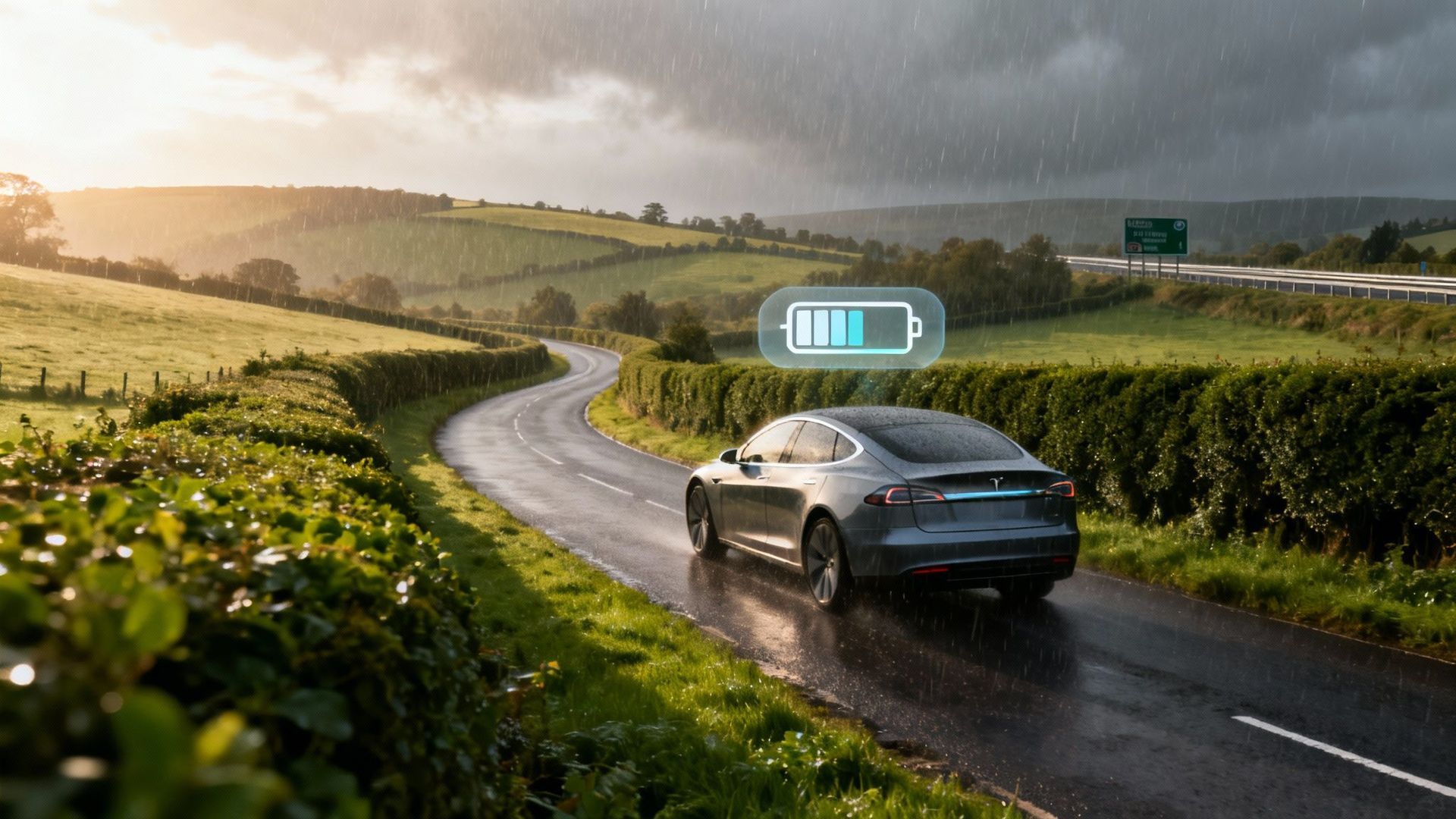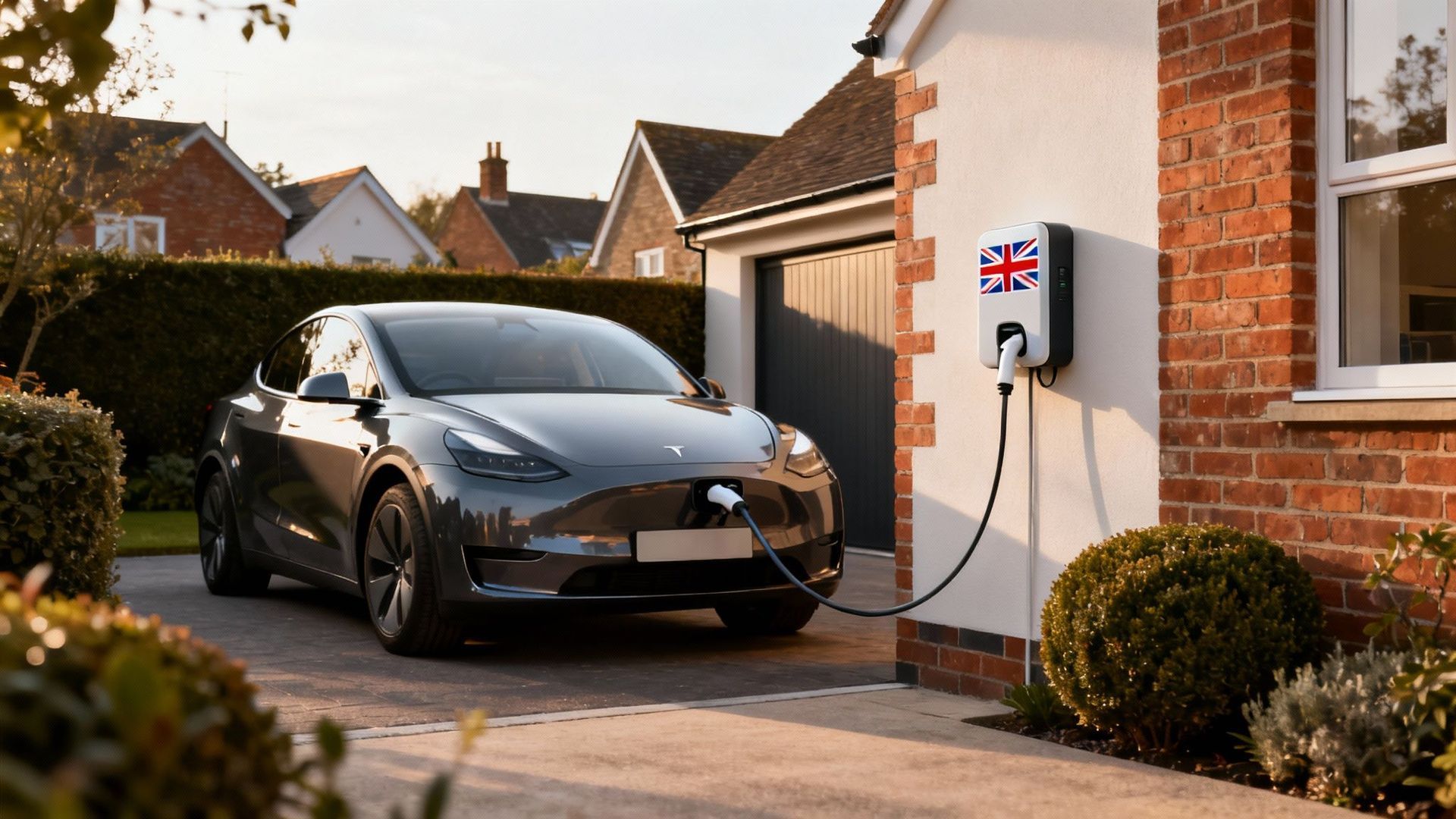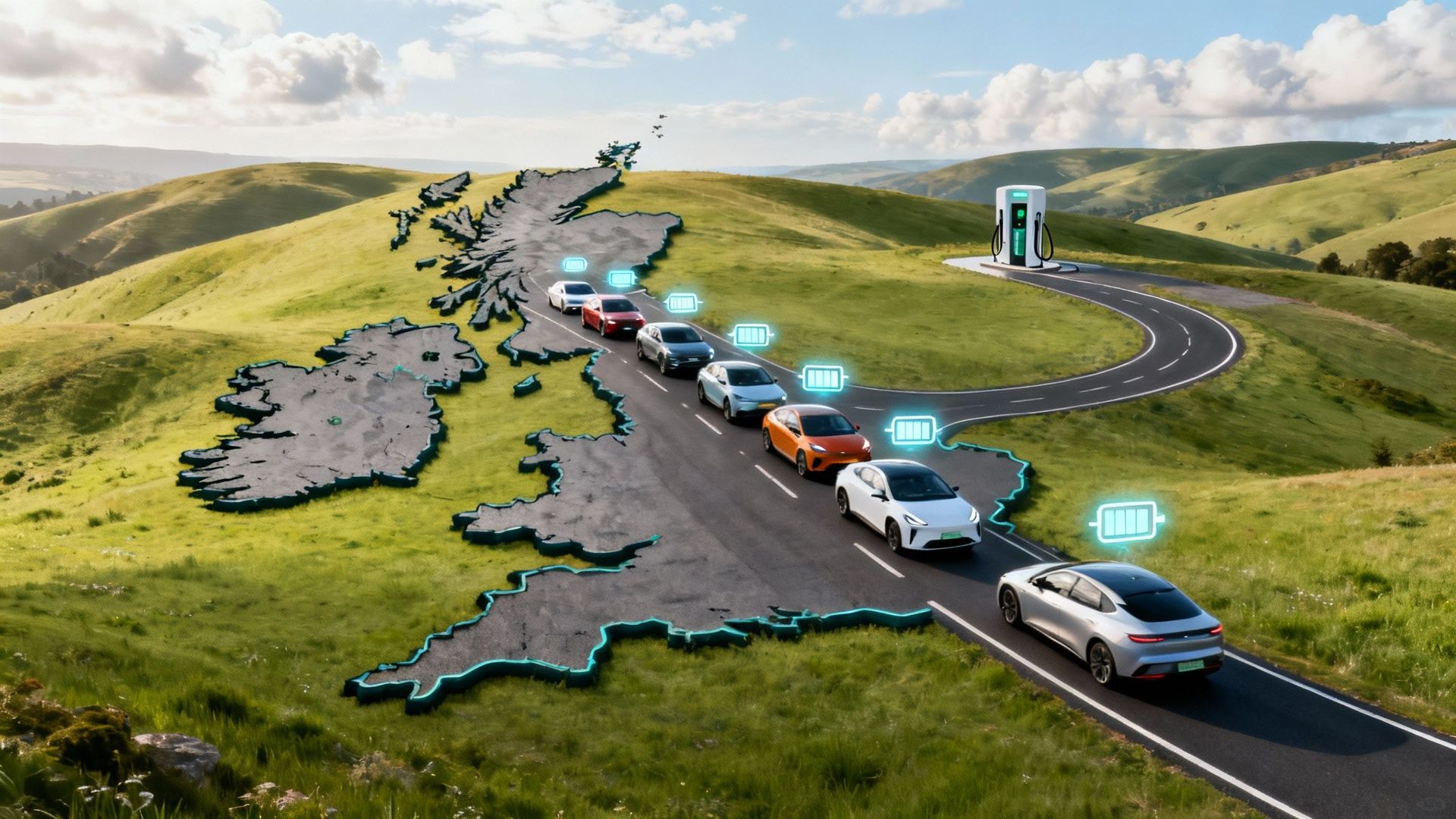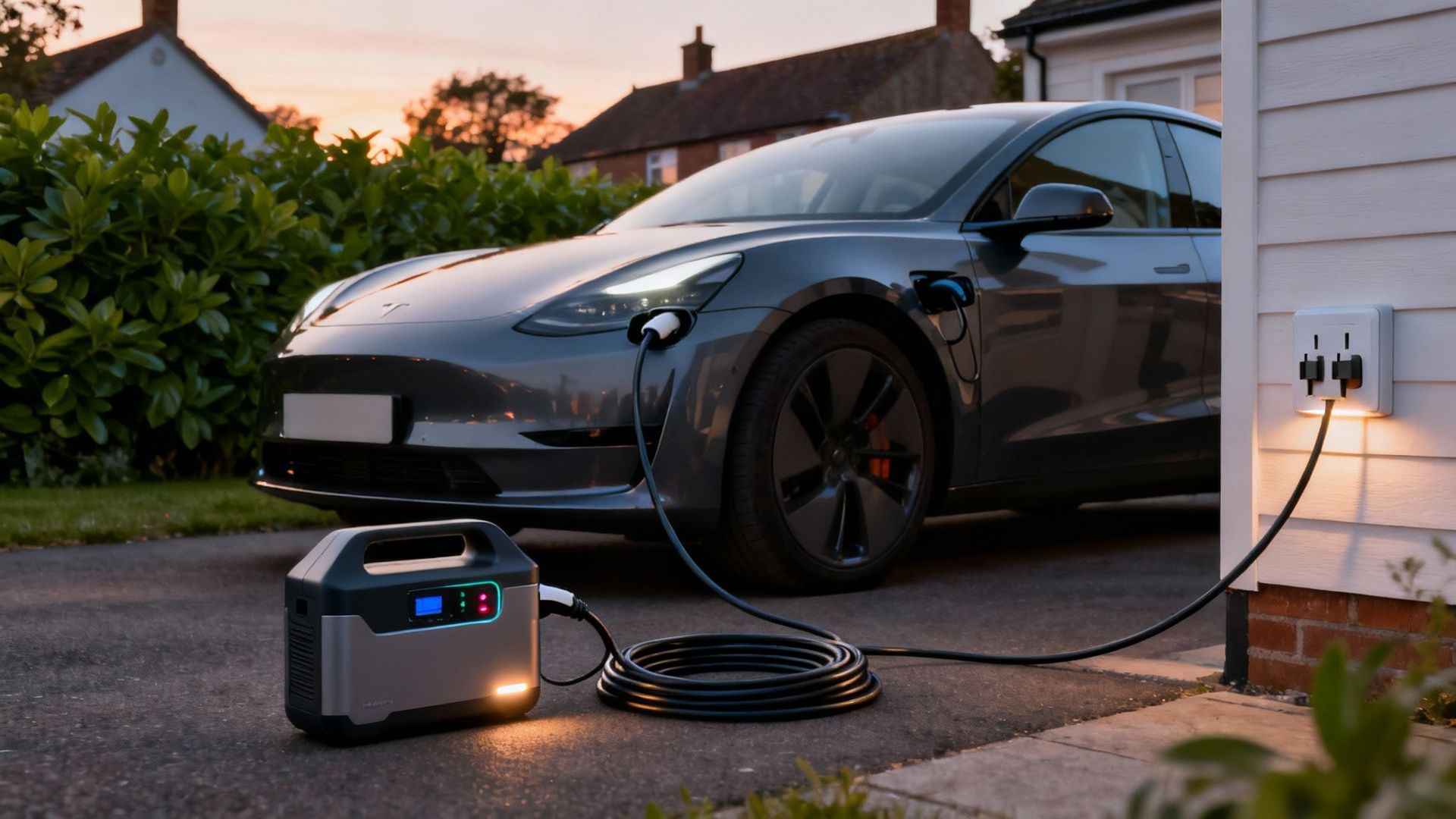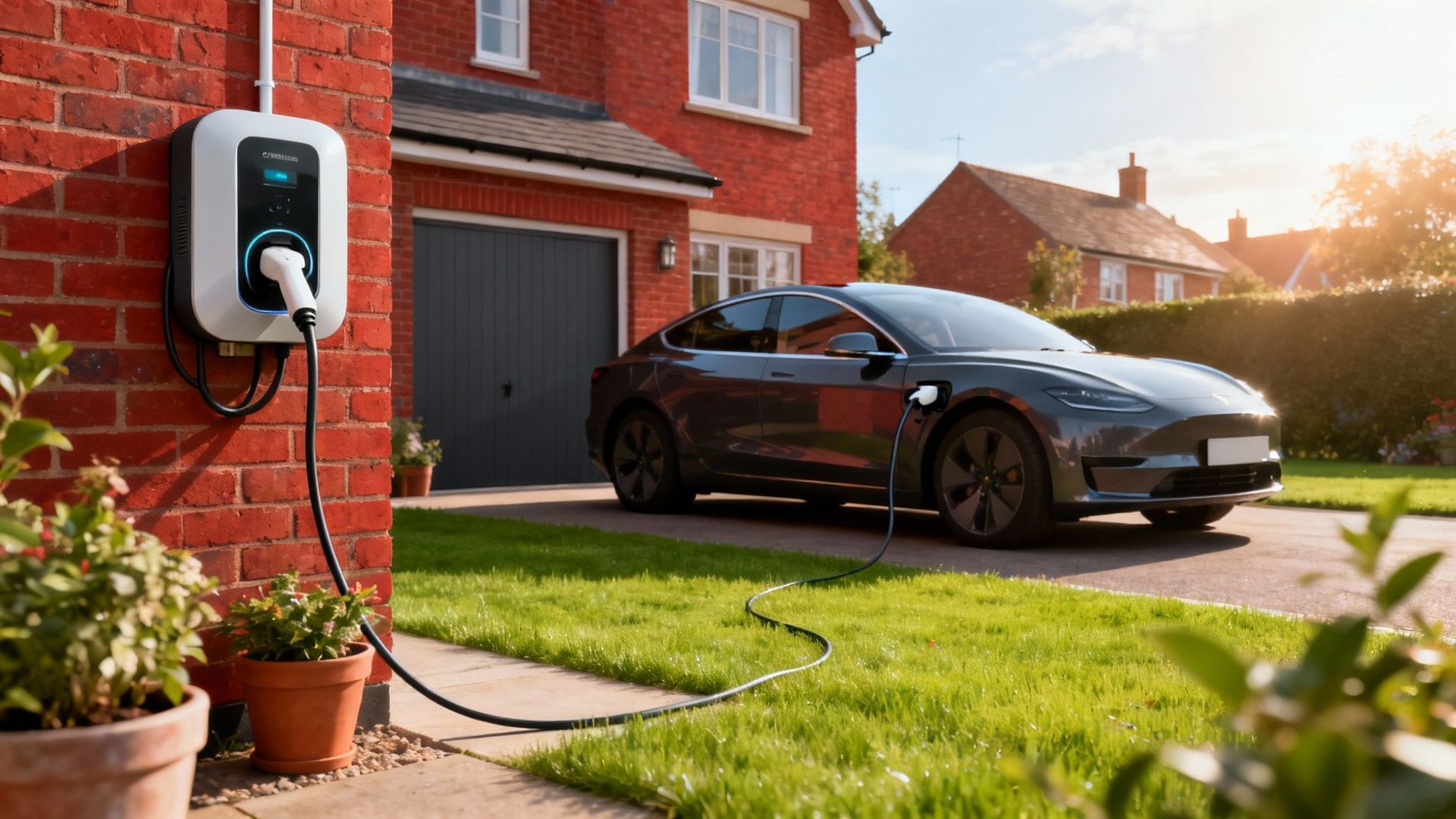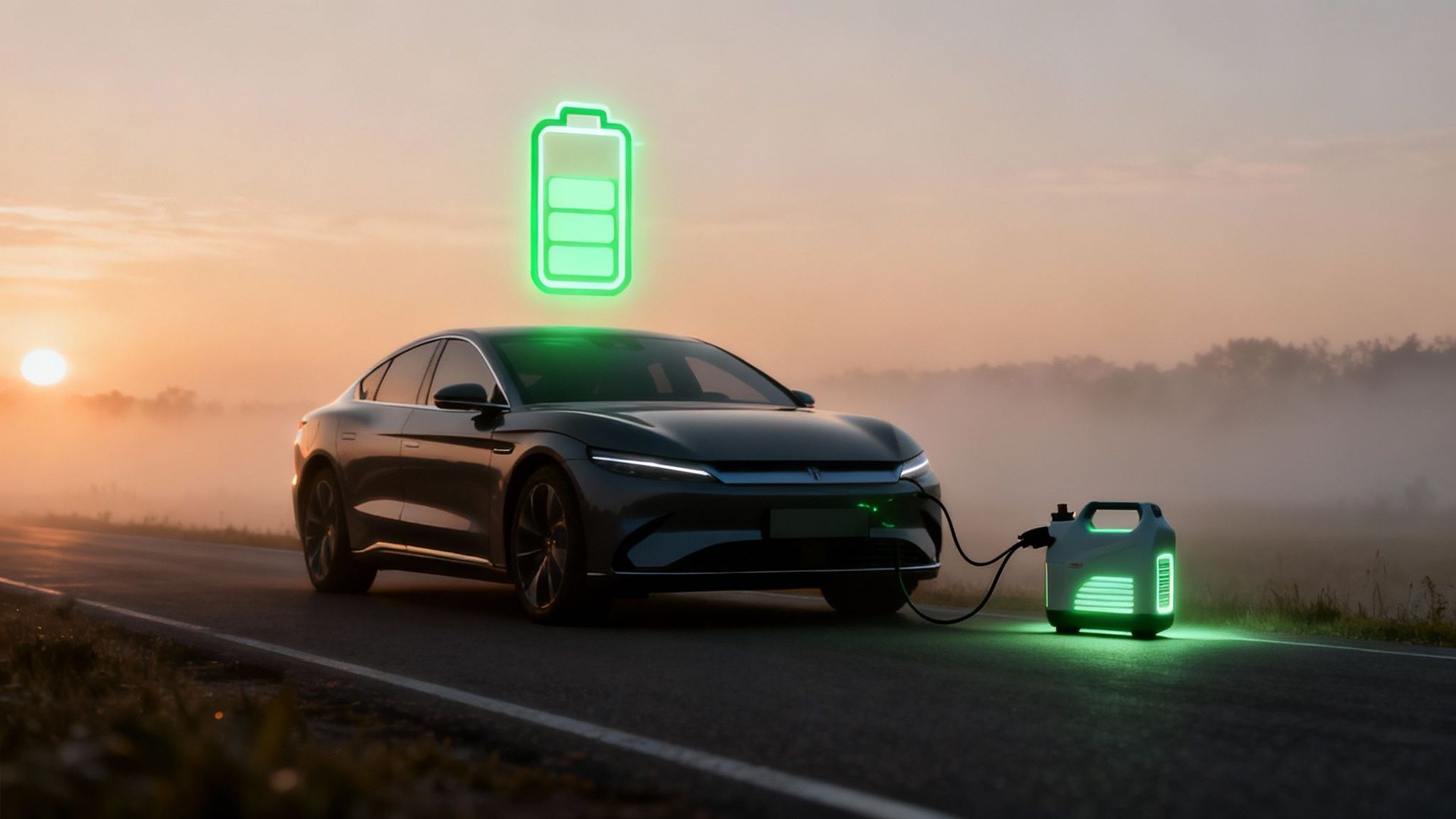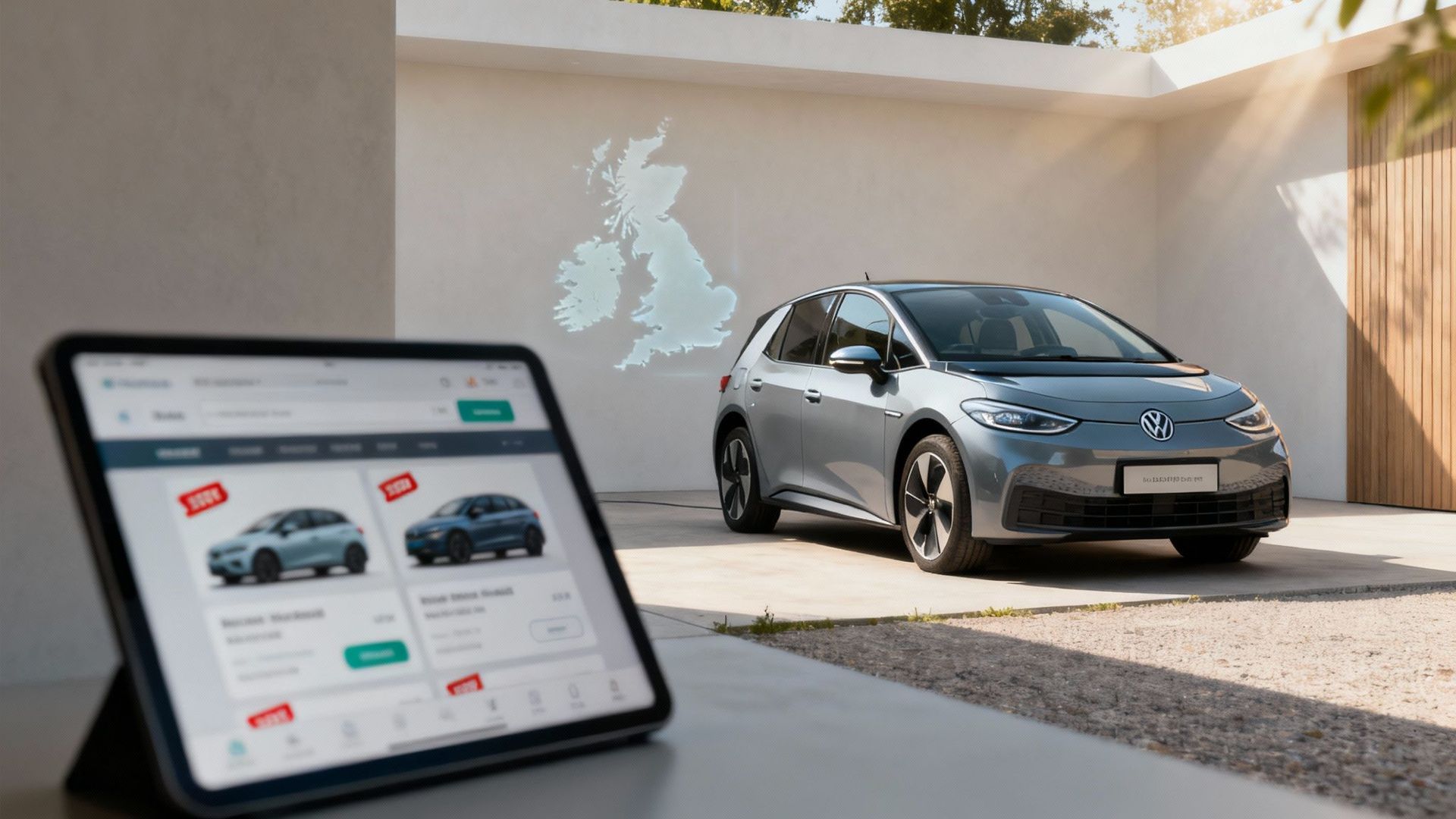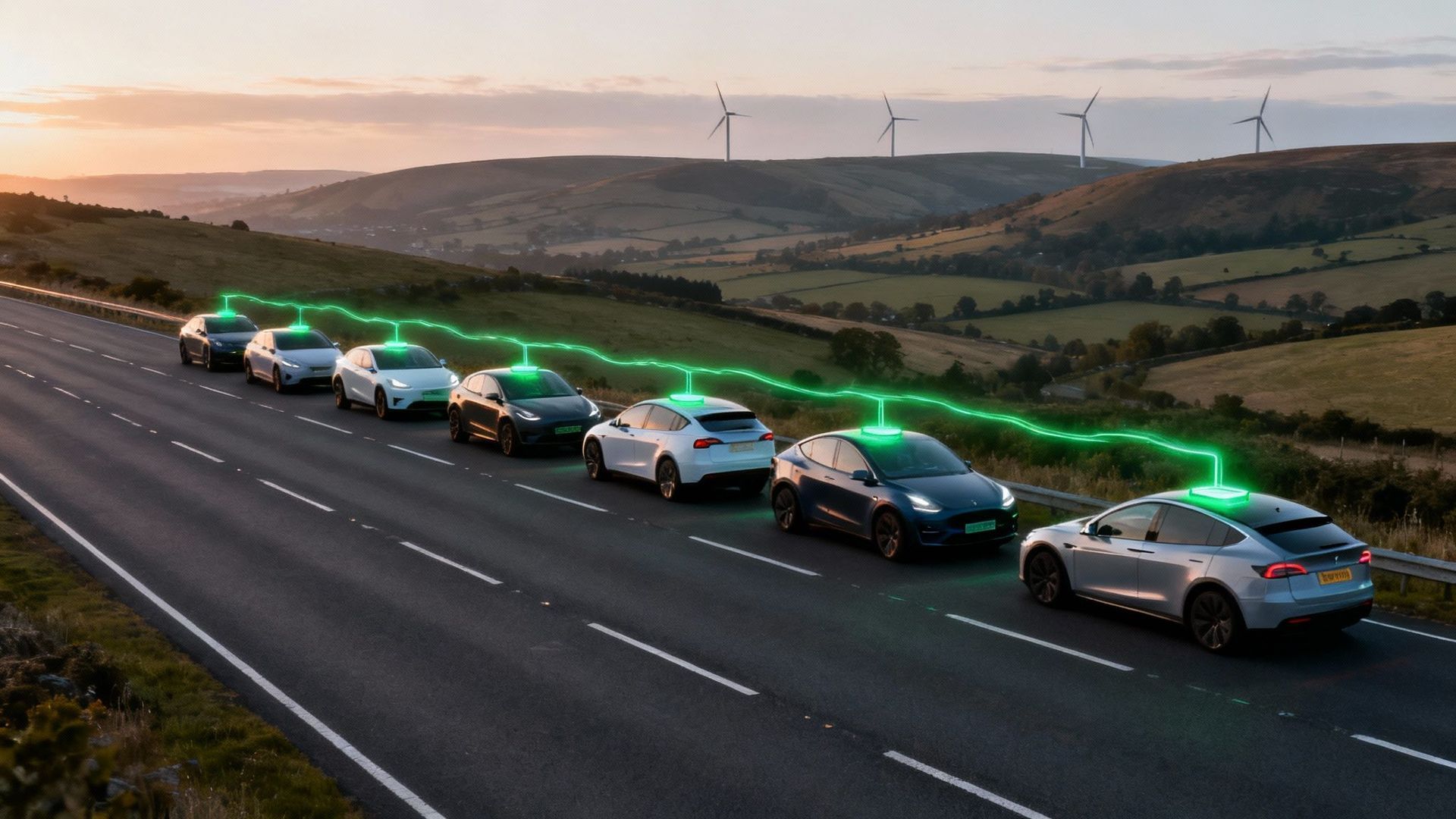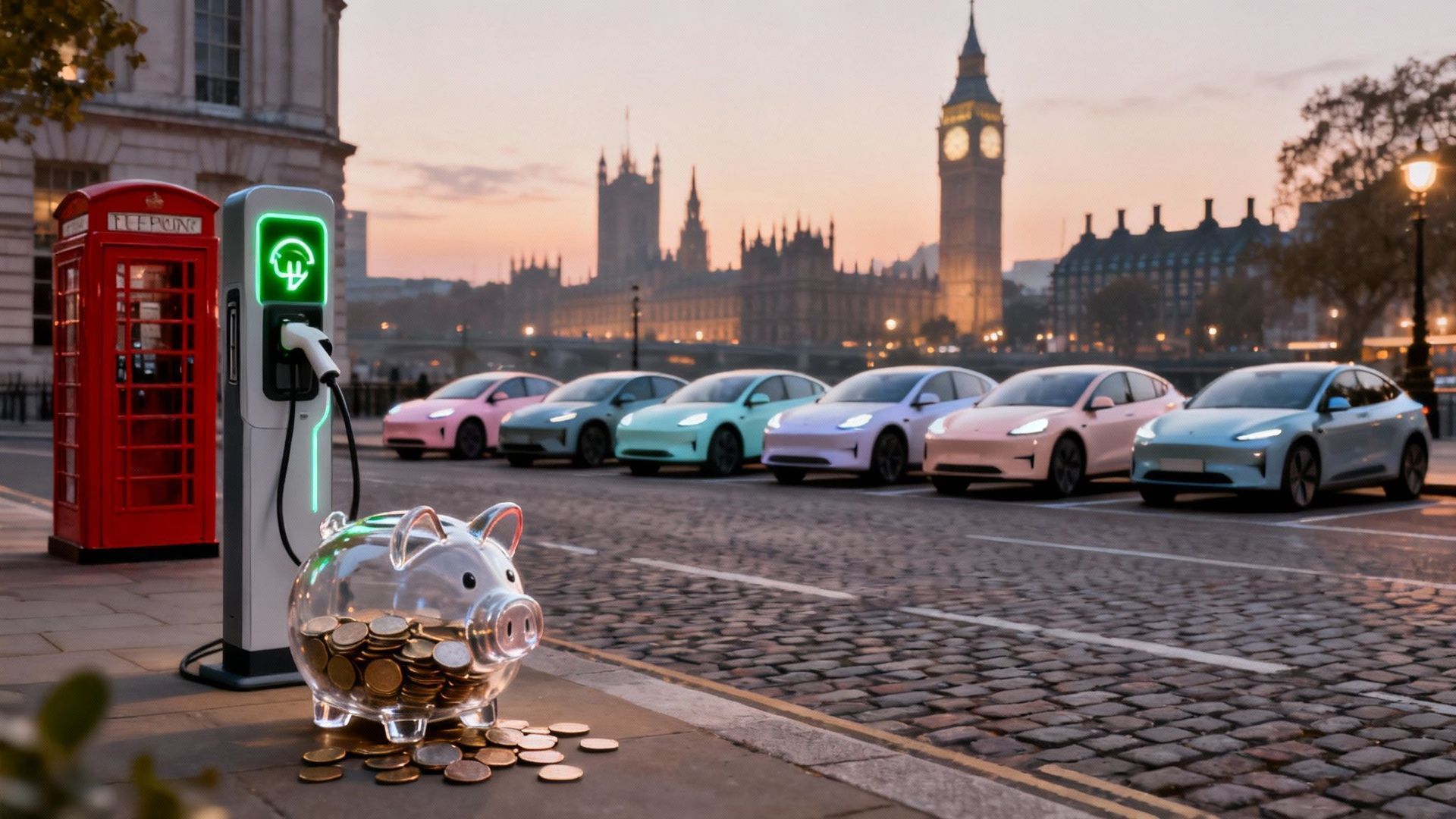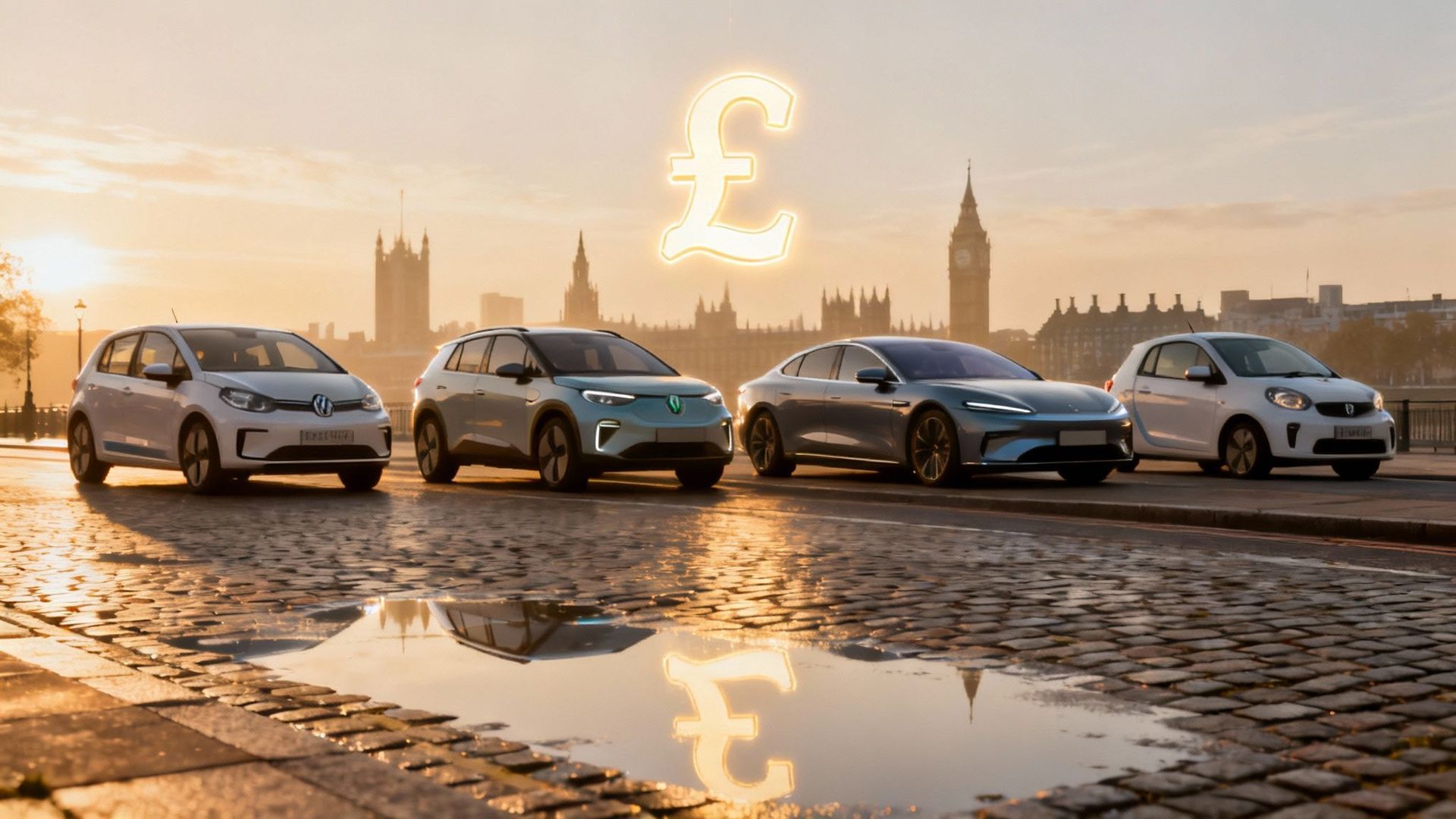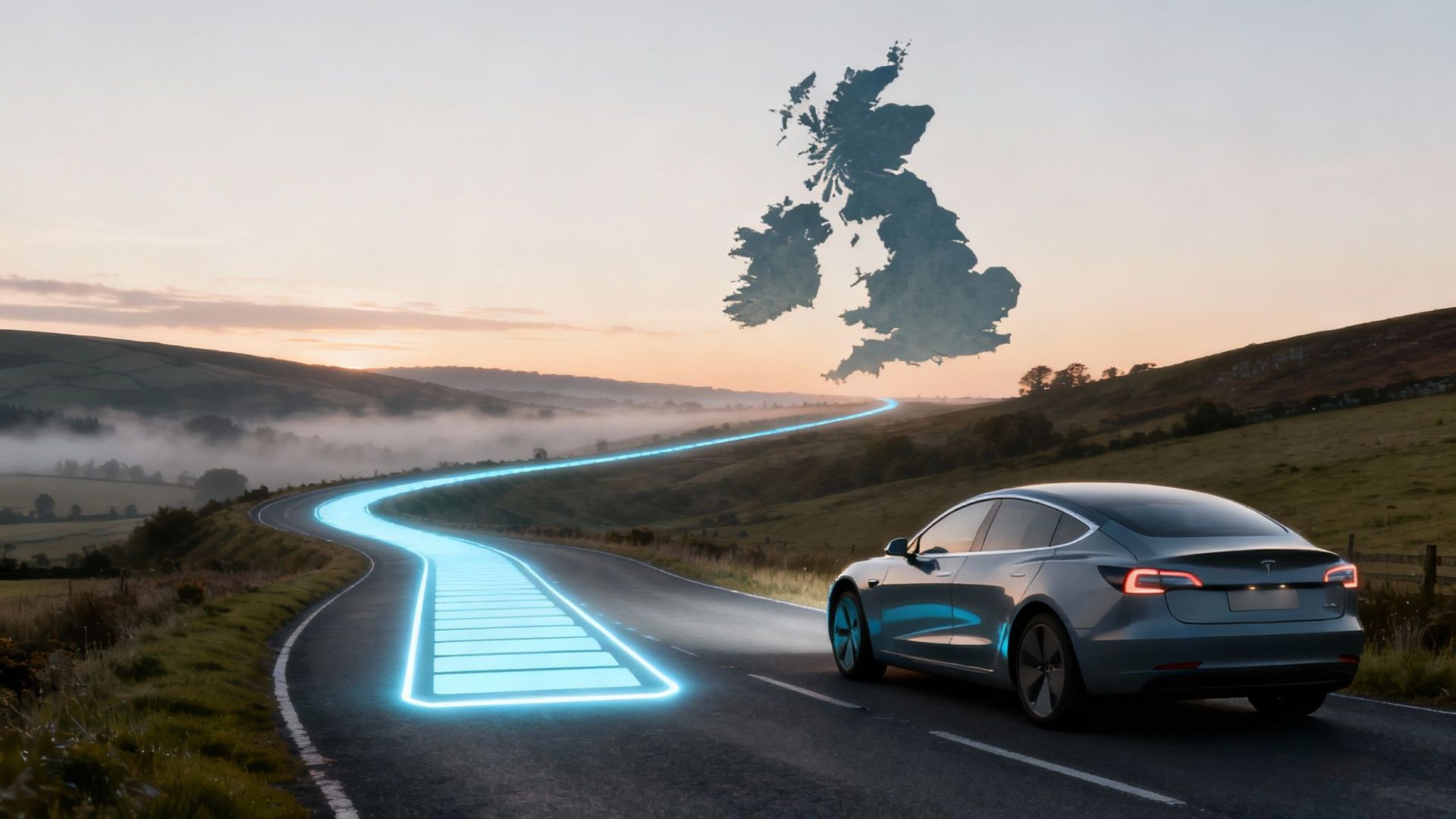UK Electric Vehicle Fleet Management: A Sceptic's Guide to Not Messing It Up
So, you're toying with the idea of swapping your fleet of clattering, diesel-belching workhorses for a bunch of silent electric vans. A brave move. At its heart, electric vehicle fleet management is the art and science of running those vehicles without everything grinding to a halt, but with a few clever twists. Forget glorified milk floats; this is about using smart tech to make your business leaner, greener, and quiet enough to hear your accountant weep with joy.
Binning the Spreadsheet for Smarter Fleet Control
Let's be honest, the phrase 'electric vehicle fleet management' sounds like a corporate headache cooked up in a windowless boardroom. It conjures images of incomprehensible charts and someone droning on about telematics. But the reality is far more interesting and, frankly, much more profitable.
Think of it like this: you could navigate London with a crumpled, tea-stained A-Z, or you could use a live traffic app on your phone. The old way works , sure, but the new way gets you there faster, cheaper, and with a lot less swearing. This isn't just about swapping petrol for plugs; it's about giving your entire operation a much-needed brain upgrade.
So What Does This Actually Mean for You?
At its core, managing an electric fleet means shifting how you think. Instead of just tracking fuel cards and mileage, you're now overseeing a connected ecosystem. A proper management platform doesn't just tell you where your vans are; it becomes the central nervous system for your entire day-to-day operation.
This modern approach brings a few key elements into play that separate the pros from the hopelessly panicked:
- Intelligent Charging: Imagine automatically telling vehicles to charge when electricity is dirt cheap overnight. You could slash your energy bills without anyone lifting a finger. Genius.
- Route Optimisation: This is about planning daily routes that actually account for battery range and available charging points, stamping out the dreaded "range anxiety" for good.
- Real-Time Monitoring: You can keep an eye on everything from battery levels and vehicle health to driver behaviour. It helps you spot who has the heaviest right foot and is costing you a fortune.
- Maintenance Forecasting: Electric vehicles have far fewer moving parts, which means less time in the garage. Smart systems can predict when servicing is actually needed, preventing costly, unexpected downtime.
In essence, you're moving from a reactive model of fixing problems as they happen to a proactive one where software anticipates issues before they can derail your day. It’s about squeezing every last drop of efficiency from your assets.
This guide will cut through the jargon. We’ll show you how to embrace this new way of working to get ahead of your competitors, make your accountant happy, and finally get some peace and quiet at the depot. Forget the logistical nightmares; this is your blueprint for a smarter, more resilient business.
Weighing the Real Costs and Benefits of Going Electric
Let's be blunt: switching your entire fleet to electric sounds like a monumental faff, and an expensive one at that. Why bother? It’s a fair question. The answer, however, goes far beyond just looking like a planet-saving hero or smugly driving past petrol stations.
The truth is, while the initial price tag can make your accountant twitch, the long-term financial picture is far rosier. It’s about playing the long game. The perks are real, tangible, and go straight to your bottom line once you get past the initial shock.
The Sunny Side of Electrification
The most obvious win is ditching volatile fuel prices. Managing a budget when diesel costs change more often than the British weather is a nightmare. With electricity, especially when you factor in smart, off-peak overnight charging, your costs become predictable and, more importantly, significantly lower .
But the savings don't stop there. Electric vehicles have far fewer moving parts than their clunky internal combustion engine cousins. Say goodbye to oil changes, exhaust systems, and a whole host of other greasy bits that regularly fail. This translates to less time in the garage and more time on the road, actually earning you money.
Then there’s the government’s box of treats for businesses making the switch. The UK is keen to see more electric vans on the road, and they’re putting their money where their mouth is to make it attractive.
- Tax Breaks: Generous tax incentives, like the Enhanced Capital Allowance (ECA), can make the initial outlay far more palatable for your finance department.
- Company Car Tax Benefits: If your fleet includes company cars, the Benefit-in-Kind (BIK) tax rates for EVs are ludicrously low compared to petrol or diesel models. It's a massive perk.
- Clean Air Zone Immunity: With cities like London, Birmingham, and Bristol cracking down on emissions, an electric fleet can operate in these zones without incurring daily charges. That alone can save a small fortune over a year.
The Inevitable Hurdles You Can't Ignore
Of course, it’s not all sunshine and savings. Pretending there are no downsides would be disingenuous. The single biggest barrier is the upfront cost . Electric vans are still more expensive to buy than their diesel equivalents, and that’s a significant hurdle for any budget.
Then you have the infrastructure to consider. You can't just plug a fleet of 20 vans into the nearest wall socket. You’ll need to invest in a proper depot charging solution, which adds another layer of cost and logistical planning to the project.
This image shows how a modern electric fleet operation works, with a manager using data to fine-tune routes and charging schedules, turning potential hurdles into strengths.

The key takeaway is that effective electric vehicle fleet management relies on smart technology to balance vehicle availability, charging times, and energy costs efficiently.
And let’s not forget the infamous ‘range anxiety’. While it’s often overblown—most modern electric vans can handle a typical day's work with ease—it’s a genuine concern that needs to be managed with smart route planning and proper driver training.
The decision to go electric is a classic case of short-term pain for long-term gain. The initial investment is hefty, but the ongoing operational savings in fuel, maintenance, and taxes create a compelling business case over the vehicle's lifetime.
Despite these challenges, the momentum is undeniable. The UK's fleet sector is a major driver of EV adoption, with new battery-electric vehicle (BEV) registrations increasing by 34.6% in the first half of the year. They now make up 21.6% of the new car market, thanks in large part to those juicy tax incentives. You can explore more about the UK's rapid EV fleet expansion and its drivers.
Understanding both sides of this coin is the only way to make a decision that genuinely works for your business.
A No-Nonsense Cost Comparison for Your Fleet
So, how do the numbers really stack up? Here’s a straightforward look at a traditional fossil-fuel fleet versus a new electric one, covering everything from the purchase price to the day-to-day running expenses.
| Cost Factor | Traditional Diesel or Petrol Fleet | Electric Vehicle (EV) Fleet |
|---|---|---|
| Purchase Price | Lower initial capital outlay. | Higher upfront cost per vehicle. |
| Fuel Costs | High and volatile. Subject to global market fluctuations. | Significantly lower and more stable. Further reduced with smart/off-peak charging. |
| Maintenance | Regular and costly: oil changes, filter replacements, exhaust systems, etc. | Minimal. Fewer moving parts mean less wear and tear. No oil or exhaust to worry about. |
| Taxation (BIK) | Higher Benefit-in-Kind (BIK) tax rates for company car drivers. | Very low BIK rates, making it a huge perk for employees. |
| Government Grants | Limited to none. | Access to various government grants and incentives to offset the purchase price. |
| Zone Charges | Subject to daily charges in Clean Air Zones (CAZ) and ULEZ. | Exempt from CAZ/ULEZ charges, leading to major savings for urban operations. |
| Resale Value | Declining, as regulations tighten and demand for diesel/petrol falls. | Currently strong and projected to remain so as the 2035 deadline approaches. |
It's clear that while the initial cheque you write for an EV fleet will be larger, the ongoing savings on fuel, maintenance, and taxes paint a very different picture over the long term.
The Essential Tech for a Smarter EV Fleet
Trying to run an electric fleet without the right tech is like trying to navigate London with a map from the 1980s. It’s pointless, frustrating, and almost certain to end in operational chaos. To avoid that kind of meltdown, you need a modern toolkit. This isn't about collecting shiny gadgets; it’s about the core software and hardware that turn a group of electric vans into a coordinated, efficient, and profitable operation.
Let's cut through the buzzwords. The heart of any decent electric vehicle fleet management system is a single, intuitive platform that acts as your mission control. This is where the magic really happens, turning what could easily become a logistical nightmare into a well-oiled machine.

This central hub pulls in data from every vehicle on the road, giving you the complete picture without having to drown yourself in spreadsheets. It’s the difference between guessing and knowing.
Meet Your New Best Friend: Telematics
At the core of this tech stack is telematics . The simplest way to think about it is as a Fitbit for your vans. A small device fitted inside each vehicle constantly sends back a stream of vital information, and it's this data that makes proactive management truly possible.
This goes far beyond just sticking a pin on a map. Modern telematics for EVs provides a wealth of specific, actionable data that’s absolutely crucial for an electric fleet:
- Real-Time Battery Status: See the State of Charge (SoC) for every single vehicle at a glance. This completely eliminates the guesswork and helps prevent drivers from getting stranded with a flat battery.
- Energy Consumption: Pinpoint exactly how much energy is being used per mile. This can help you identify inefficient driving habits or even spot vehicles that might need a mechanical check-up.
- Driver Behaviour Monitoring: Keep an eye on harsh braking, rapid acceleration, and speeding. With an EV, smoother driving doesn't just improve safety—it significantly extends the vehicle's battery range.
This constant flow of data allows you to make decisions based on what’s actually happening on the road, not what you think is happening. It lets you spot a potential problem—like a battery draining faster than usual—long before it brings a delivery to a grinding halt.
This level of insight is fundamental. It empowers you to create optimised routes that take real-world battery levels into account, ensuring that a planned charging stop is a convenience, not an emergency.
Smart Charging: The Unsung Hero
Once your vehicles are back at the depot, the next critical piece of technology comes into play: smart charging . This is so much more than just plugging a van into a socket. Smart charging systems communicate directly with both the vehicles and the electricity grid to manage the entire process.
It’s an absolute game-changer for controlling costs. Instead of a free-for-all where every vehicle starts charging the moment it returns—often during peak, expensive electricity hours—the system takes control.
You can set rules so that vehicles charge automatically when tariffs are at their lowest, usually in the middle of the night. The system also manages the electrical load, preventing you from blowing the main fuse by trying to charge 20 vans all at once. It intelligently staggers the charging sessions to stay within your site's power limits.
- Load Balancing: Distributes the available power across multiple chargers to avoid overloading your electrical supply.
- Scheduled Charging: Automatically starts and stops charging based on off-peak electricity tariffs, which can slash your energy bills.
- Prioritisation: Makes sure that the vehicles needed earliest the next day are the first to be fully charged and ready to go.
Choosing the right charging infrastructure is a strategic decision that goes hand-in-hand with your software. For a deeper dive into your options, you can learn more about the EV charging landscape in the UK in our detailed guide.
Ultimately, it’s the combination of a powerful fleet management platform, detailed telematics, and intelligent charging infrastructure that makes an electric fleet not just viable, but superior. This is the gear that prevents chaos and quietly works in the background to make your entire operation smarter and more profitable.
Calculating Your Total Cost of Ownership
Right, let’s talk brass tacks. How much is this electric adventure actually going to set you back? More importantly, when does it start paying you back? We need to look beyond the green credentials for a moment and build a business case that proves going electric is a genuinely shrewd financial move.
This is where the concept of Total Cost of Ownership (TCO) comes in. It’s simply a way of adding up everything – not just the shiny price tag on the windscreen. Judging an EV on its purchase price alone is like judging a pint by the glass it comes in; you’re missing the good stuff inside.
TCO gives you the full, unvarnished picture of your investment over the vehicle's entire life. It’s the tool that will stop your accountant from having a meltdown and prove you’ve done your homework.
Beyond the Purchase Price
The first number is always the scariest: the initial outlay for the vehicles and charging infrastructure. Yes, it’s a hefty sum, and nobody is pretending otherwise. But this is where the clever part begins, because from day one, you also need to factor in the money flowing back your way.
Government incentives are your first port of call. Grants like the Workplace Charging Scheme can significantly soften the blow of installing chargers at your depot. These aren't just token gestures; they’re designed to make that initial investment far more digestible for UK businesses.
Here’s a snapshot of the official guidance, outlining the rules and voucher values you can claim.
Getting your head around these schemes is vital. They directly reduce your upfront capital expenditure and speed up your return on investment.
The Real Running Costs Unmasked
This is where the financial case for an EV fleet truly comes alive. You need to meticulously compare your projected electricity bills against your current—and likely painful—fuel receipts. With smart charging, you can refuel an entire fleet overnight on cheap, off-peak electricity tariffs for a fraction of what diesel would cost.
Then there’s maintenance, or rather, the glorious lack of it. Electric vehicles have no oil to change, no exhaust systems to rust through, and no clutch to wear out. This means fewer trips to the garage, less vehicle downtime, and a much healthier maintenance budget. Over a five-year period, these savings alone can be substantial.
The breakeven point—that magic moment your EV fleet stops costing you money and starts saving it—is typically reached much sooner than sceptics would have you believe. For many UK fleets with predictable daily routes, this can happen within just a few years.
This shift is happening right now across the UK. The market for traditional petrol and diesel vehicles is in a nosedive, with sales falling by 22.0% and 26.2% respectively. In stark contrast, battery-electric vehicles saw an 8.1% increase in registrations, capturing a 20.4% market share. It's a clear signal that fleet managers are voting with their wallets. You can find out more about these shifting UK market dynamics on the Alternative Fuels Observatory.
By building a comprehensive TCO model, you transform the conversation from "Can we afford this?" to "How can we afford not to do this?". For a more granular breakdown, check out our guide on the real cost of owning an EV compared to petrol cars, which digs even deeper into the numbers.
A Practical Plan for Fleet Electrification
Alright, you're convinced. The benefits of an electric fleet are clear. But how do you actually make the switch without your daily operations grinding to a halt in a spectacular festival of confusion and flat batteries? This isn't a theoretical exercise anymore; this is your step-by-step, chaos-avoidance plan.
Jumping in with both feet and swapping your entire diesel fleet overnight is a recipe for disaster. A phased, methodical rollout is the only sane approach. You need to start by identifying the ‘low-hanging fruit’—those easy wins that will build confidence and prove the concept really works in your specific context.

This gradual approach lets you learn the ropes, iron out the inevitable kinks, and scale up intelligently rather than impulsively.
Start Small With Easy Wins
First things first, look at your current operation and pinpoint the perfect candidates for an initial EV trial. These are typically the vehicles that follow short, predictable, and repetitive routes. Think local delivery vans that return to the depot every night, not the long-haul lorries heading to the Outer Hebrides.
Here’s what to look for in your pilot vehicles:
- Predictable Routes: Vehicles that cover a similar distance each day, well within the range of a modern EV. This takes range anxiety completely out of the equation.
- Return-to-Depot Operations: Vans that come back to base every evening are perfect for overnight charging, ensuring they start each day with a full "tank."
- Low Payload Work: While electric vans are perfectly capable, starting with lighter loads simplifies the initial calculations for energy consumption and performance.
By starting with these vehicles, you create a controlled experiment. You can gather real-world data on performance and costs without jeopardising your entire business if something goes wrong.
Get Your Depot Ready for Action
Before the first shiny electric van even arrives, you need to play electrician. A proper site survey is non-negotiable. You’ll need a professional to assess your depot’s electrical capacity. Can your current setup handle the extra load of multiple chargers, or will plugging them in blow every fuse and plunge the neighbourhood into darkness?
This survey will determine where to install your chargers for maximum efficiency and whether you need to upgrade your connection to the grid. Getting this wrong is an expensive and disruptive mistake to fix later on.
Remember, planning your charging infrastructure is as crucial as choosing the vehicles themselves. It's the backbone of a successful electric fleet, ensuring your vehicles are assets, not just expensive, immobile paperweights.
The UK's corporate sector is already making this move in huge numbers. In the first half of 2025, there were 224,838 new battery-electric vehicle registrations, a jump of 34.6% from the previous year. This growth has been massively fuelled by fleets taking advantage of tax incentives, while private buyer interest has actually dipped.
Train Your Drivers Not to Fear the Battery Gauge
Finally, and perhaps most crucially, you need to train your team. Your drivers are on the front line of this transition, and their buy-in is absolutely essential. Just handing them the keys with a mumbled "it’s electric, good luck" is asking for trouble.
Effective training should cover the practical realities of driving an EV for work:
- Understanding Realistic Range: Teach them how factors like speed, payload, and even the weather can affect the battery.
- Mastering Regenerative Braking: Show them how to drive in a way that puts energy back into the battery, effectively extending their range for free.
- Charging Etiquette: Explain the difference between rapid chargers on the road and depot charging, and the best practices for each.
The goal is to build confidence and turn scepticism into expertise. When your drivers understand the technology, they’ll use it more efficiently. This hands-on preparation is the key to a smooth, successful, and profitable transition to an electric fleet. Indeed, the role of government policies in accelerating EV adoption has been a massive factor, creating the incentives that make this practical plan so financially viable.
Answering Those Lingering EV Fleet Questions
Right, we’ve talked costs, tech, and the big picture. But there are always those niggly little questions that pop into your head at 3 AM – the ones you think but are maybe too polite to ask in a meeting. Let's tackle them head-on with some straight, no-nonsense answers.
It's time to bust some myths and inject a dose of reality into any lingering doubts. This isn't about sugar-coating the switch to electric; it's about being honest about the genuine worries that come with any major change in operations.
What If a Driver Runs Out of Juice in the Middle of Nowhere?
Ah, the classic nightmare. You’re picturing a driver stranded on the M6, surrounded by sheep, with a cargo of melting ice cream. It’s a powerful image, but thankfully, it’s also incredibly unlikely in a well-managed fleet.
First off, your fleet management software is designed specifically to prevent this very scenario. It plans routes that sit comfortably within a vehicle's range, slotting in charging stops only when absolutely necessary. This isn't guesswork; it's smart, data-driven planning.
But let's say the absolute worst happens. It’s not the end of the world. Mobile charging services are a growing industry – think of them as the AA, but armed with a massive power bank instead of a jerry can. Besides, modern EVs give you so many low-battery warnings you’d have to be actively trying to ignore them to get caught out. It's less ‘disaster movie’ and more ‘mildly inconvenient Tuesday’.
How Long Do the Batteries Actually Last Before They Need Replacing?
A lot longer than the one in your phone, that’s for sure. The idea that you’ll be forking out for a new battery pack every few years is one of the most persistent myths out there. Most manufacturers offer an 8-year or 100,000-mile warranty on their batteries for a simple reason: they’re built to last the life of the vehicle.
A battery doesn't just die suddenly. Instead, you'll see a very gradual decline in its maximum capacity over many, many years. By the time the battery’s performance is noticeably reduced, the van it’s sitting in will likely be showing its age and ready for retirement anyway. It’s simply not the ticking time bomb of expense many people fear.
In reality, a fleet vehicle is far more likely to be retired due to general wear and tear or reaching the end of its lease term long before its battery becomes a critical issue. Data from thousands of EVs shows that battery health remains remarkably robust over time.
This durability is a huge part of what makes the electric vehicle fleet management total cost of ownership so appealing in the long run.
Can the National Grid Really Handle All These Electric Vans?
This is a fair question, often followed by visions of the entire country plunging into darkness because every business plugs in its vans at 5 PM. It's a popular myth, but the reality is far more organised and, well, a lot smarter than that.
The secret weapon here is smart charging . As we’ve discussed, this technology ensures vehicles charge during off-peak hours when demand on the grid is low and electricity is cheaper. It’s not a chaotic free-for-all; it’s a coordinated, intelligent process that balances the load.
On top of that, the National Grid isn't a static, unchanging thing. It's constantly being upgraded and strengthened to handle future demand. The shift to electric fleets is happening gradually, giving the grid infrastructure plenty of time to adapt. We promise, the lights will stay on.
Will My Drivers Just Be Sitting Around for Hours Waiting for Vehicles to Charge?
Only if your charging strategy is rubbish. The image of drivers playing on their phones for half the day while a van charges is a sign of poor planning, not a fundamental flaw in the technology.
For almost any fleet, the most efficient solution is overnight depot charging. The vehicles work their shift, return to base, and get plugged in. By the next morning, they are fully charged and ready to go, just like your smartphone. Zero driver downtime, zero waiting.
For those rare, longer routes that might need a top-up, the public rapid charging network comes into play.
- Rapid Charging: A quick 20-30 minute stop—about the time it takes for a driver to grab a coffee and use the loo—can add over 100 miles of range to most modern electric vans.
- Integration, Not Interruption: The key is to build this brief stop into the driver's existing, legally required break schedule.
It’s all about weaving charging into the natural workflow, not creating new periods of inactivity. If your drivers are waiting for hours, you need to look at the management strategy, not the vehicle.
Ready to silence the sceptics and get the real story on all things electric? VoltsMonster is your go-to source for honest reviews, practical guides, and entertaining content that cuts through the noise. Explore our articles and join the conversation at https://www.voltsmonster.com.

